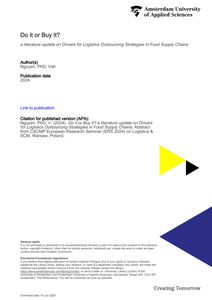Outsourcing of business processes and information technology (IT) operations is an important trend in large and middle-sized organizations. However, outsourcing could affect the organization’s ability to align its IT with business strategy and operations. This article reports a qualitative study into the relationship between IT outsourcing (ITO) and business and IT alignment. It aims to provide recommendations for outsourcers and service providers on how outsourcing relationships should develop in order to support business and IT alignment. The research question of the study is “What is the effect of IT outsourcing on the business and IT alignment of companies that have outsourced their IT?”After a review of relevant literature and concepts, four cases are reported. The study revealed that a higher level of motivation for outsourcing paired with a higher level of the relationship between outsourcer and service provider and with a higher level of alignment maturity of the outsourcer. The study also showed that the ITO relationship is influenced by organizational turbulence on one or either side of the relationship and that the service providers tend to assess the relationship on a higher level than the outsourcers. These conclusions provide relevant directions for both outsourcers and service providers for improvement of the their relationship
DOCUMENT

In Dutch higher education institutions, IT outsourcing (ITO) is becoming more common. New applications nowadays are executed from the ‘cloud’. But what to do with on premise applications? Can they also be outsourced? If so, what factors does a higher education institution have to consider when making the ITO decision of their on-premise applications? This research starts with finding the factors that are already known in existing ITO literature (in different contexts). Then, these decision factors are validated in four explorative interviews before surveying the factors within a higher education context. In total, fourteen factors are deemed to be important for Dutch higher education institutions. Based upon the survey responses by Dutch IT decision makers, a hierarchy exist in these fourteen factors. Also, this research suggest a relationship between outsourcing decision factors and the sourcing models. Additionally, outsourcing objectives seem to influence this relationship.
LINK
This paper analyzes the application of PRINCE2® in a multivendor outsourcing context. Given the ongoing trend in large and middle-sized organizations to outsource part of their IT operations it is relevant and important to understand the effect of this trend on the way projects can be managed. Based on an analytical and qualitative approach, using an expert panel, the study provides identified three specific considerations for the management of projects in a multi vendor outsourcing context
DOCUMENT

Accepted abstract to present at the CSCMP European Research Seminar (ERS 2024) on Logistics & SCM, to be held on June 20-21, 2024, in Warsaw, Poland.
DOCUMENT

Henry Ford onderscheidt drie verschillende generaties binnen outsourcing: coming together, staying together en working together. 'Coming together is a beginning. Staying together is progress. Working together is succes.' Maar zijn we overal al in de fase van working together? Ik denk van niet. Daarom is het boeiend om in de special edition van MIS Quarterly eens te lezen wat de status van de wetenschap is omtrent offshoring.
DOCUMENT

Recensie van het boek "Uitbesteding van IT dienstverlening" van Dr. Erik Beulen
DOCUMENT

For IT services companies, delivering high quality IT services is of eminent importance. IT service quality drives customer satisfaction, which in its turn drives firm performance. It is this link that is addressed in this paper: How can the performance of customer service delivery teams be improved, when looked upon from the perspective of firm performance? Based on the literature on excellent performing organizations, we apply the concepts that, according to Collins (2001), drove the development of 'good' companies to 'great' companies to a case study of an under performing service delivery team that developed into an excellent performing service delivery team. The lessons from this study were that most of the drivers behind the performance improvement of this team were in fact 'soft' factors that concerned the human side of the team more than the organizational, procedural or structural measures.
DOCUMENT

Verslag van een bezoek in mei 2009 aan India als onderdeel van een delegatie van KPN. In een week werden bezoeken gebracht aan 7 IT leveranciers van KPN, 3 universiteiten en waren er gesprekken met diverse andere partijen. Daarbij zijn de steden Mumbai, Pune, Bangalore en Chennai aangedaan. Dit verslag geeft een beeld van de stand van zaken op het gebied van IT & Business Process Outsourcing in India. REP-09-01
DOCUMENT

‘Bedrijfsprocessen uit de cloud, business rules als succesfactor’ is een publicatie van het Platform Outsourcing Nederland en is het verslag van een onderzoek van de Hogeschool Utrecht, Lectoraat Extended Enterprise Studies, die tot stand is gekomen met een subsidie van het PON (Platform Outsourcing Nederland).
MULTIFILE

It is well-documented that international enterprises are more productive. Only few studies have explored the effect of internationalization on productivity and innovation at the firm-level. Using propensity score matching we analyze the causal effects of internationalization on innovation in 10 transition economies. We distinguish between three types of internationalization: exporting, FDI, and international outsourcing. We find that internationalization causes higher levels of innovation. More specifically, we show that (i) exporting results in more R&D, higher sales from product innovation, and an increase in the number of international patents (ii) outward FDI increases R&D and international patents (iii) international outsourcing leads to higher sales from product innovation. The paper provides empirical support to the theoretical literature on heterogeneous firms in international trade that argues that middle income countries gain from trade liberalization through increases in firm productivity and innovative capabilities.
DOCUMENT
